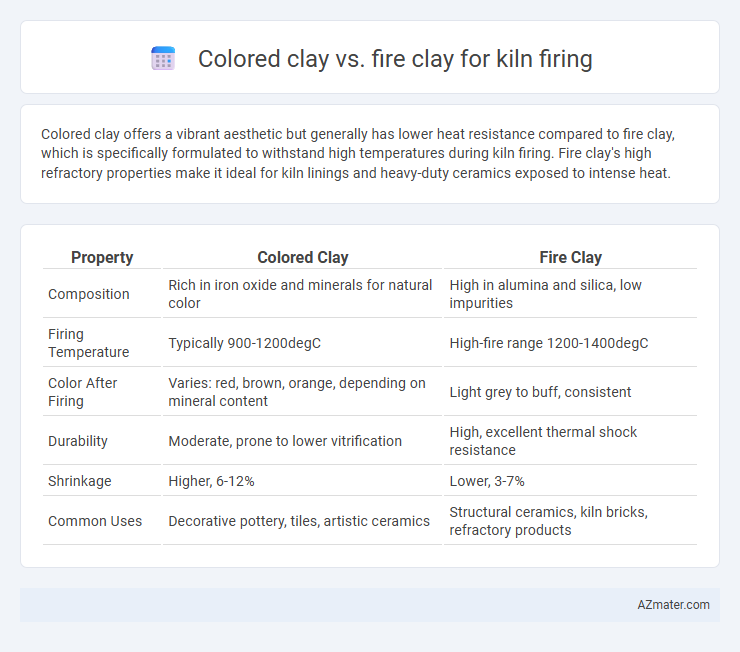Colored clay offers a vibrant aesthetic but generally has lower heat resistance compared to fire clay, which is specifically formulated to withstand high temperatures during kiln firing. Fire clay's high refractory properties make it ideal for kiln linings and heavy-duty ceramics exposed to intense heat.
Table of Comparison
| Property | Colored Clay | Fire Clay |
|---|---|---|
| Composition | Rich in iron oxide and minerals for natural color | High in alumina and silica, low impurities |
| Firing Temperature | Typically 900-1200degC | High-fire range 1200-1400degC |
| Color After Firing | Varies: red, brown, orange, depending on mineral content | Light grey to buff, consistent |
| Durability | Moderate, prone to lower vitrification | High, excellent thermal shock resistance |
| Shrinkage | Higher, 6-12% | Lower, 3-7% |
| Common Uses | Decorative pottery, tiles, artistic ceramics | Structural ceramics, kiln bricks, refractory products |
Introduction to Colored Clay and Fire Clay
Colored clay contains natural mineral pigments that provide vibrant hues, ideal for artistic kiln firing projects requiring unique surface aesthetics. Fire clay is a highly refractory material with high alumina content, capable of withstanding extreme kiln temperatures without deformation or cracking. Both clays serve distinct functional and aesthetic roles, with colored clay emphasizing decorative effects and fire clay offering structural integrity during high-temperature firing.
Composition Differences: Colored Clay vs Fire Clay
Colored clay contains higher amounts of iron oxides and mineral pigments, giving it a distinctive hue before firing, whereas fire clay is primarily composed of kaolinite and alumina-rich minerals designed to withstand high temperatures without deforming. Fire clay typically has a higher refractory content, making it ideal for kiln linings and firebricks, while colored clay is less heat-resistant and mainly used for decorative ceramics. The mineralogical differences result in varying thermal expansion rates, affecting performance during kiln firing processes.
Physical Properties and Texture
Colored clay typically contains added oxides or pigments, resulting in a more varied texture and lower firing temperature compared to fire clay, which is highly refractory with excellent heat resistance up to 1,750degC (3,182degF). Fire clay exhibits a dense, coarse texture with high plasticity and minimal shrinkage, making it ideal for kiln linings and high-temperature applications. Colored clay's texture ranges from smooth to gritty depending on the pigment content, but it generally has lower thermal shock resistance than fire clay in kiln firing processes.
Firing Temperature Ranges
Colored clay typically fires at lower temperature ranges, around cone 04 to cone 6 (approximately 1,950degF to 2,232degF), making it suitable for earthenware and low-fire ceramics. Fire clay, known for its high refractory properties, withstands much higher firing temperatures, generally between cone 8 to cone 13 (about 2,320degF to 2,400degF), ideal for stoneware and high-fire ceramics. Understanding these temperature ranges is crucial for kiln firing to achieve optimal durability and color integrity in ceramic projects.
Color Stability After Firing
Colored clay generally offers vibrant hues before firing but can experience color shifts or fading due to mineral reactions and high kiln temperatures. Fire clay, known for its refractory properties and high alumina content, maintains color stability and structural integrity under extreme heat, making it ideal for consistent hues after firing. Choosing fire clay ensures minimal color alteration, especially in high-temperature kiln firings above 1300degC.
Workability and Forming Techniques
Colored clay often contains iron oxides or other pigments that affect its plasticity, making it more challenging to work with than fire clay, which is known for its high refractory quality and excellent workability due to its fine particle size and low impurity content. Fire clay's superior plasticity supports various forming techniques such as hand-building, wheel throwing, and casting, while colored clays may require adjustments in water content or additives to improve workability during shaping. Kiln firing performance is influenced by these textural differences, with fire clay producing more consistent shrinkage and thermal stability compared to colored clays, which might vary in behavior due to their mineral composition.
Suitability for Different Types of Pottery
Colored clay offers vibrant hues that can enhance surface aesthetics but may contain impurities affecting firing behavior, making it more suitable for decorative or low-fire pottery. Fire clay, known for its high refractory properties and heat resistance, is ideal for functional stoneware, porcelain, and high-temperature kiln firing where durability and thermal stability are critical. Selecting between colored clay and fire clay depends on the pottery's intended use, firing temperature, and desired final appearance.
Common Issues During Kiln Firing
Colored clay often contains impurities and organic materials that can cause uneven firing, warping, or discoloration when exposed to high kiln temperatures. Fire clay possesses a higher refractory quality with fewer impurities, reducing the risk of cracking and structural failure during firing cycles. Common issues during kiln firing include thermal shock, inadequate maturation, and gas release, which are more pronounced in colored clay due to its variable composition.
Cost and Availability Comparisons
Colored clay typically costs more due to the inclusion of mineral oxides and pigments that enhance aesthetic appeal, whereas fire clay is generally more affordable and widely available as a natural refractory material. Fire clay, prized for its high alumina content and heat resistance, is sourced from common deposits, making it readily accessible for kiln construction and repair. Colored clay, while desirable for artistic kiln linings or decorative ware, may have limited local availability and demand higher procurement costs.
Choosing the Right Clay for Your Kiln Project
Colored clay offers vibrant hues and unique textures ideal for decorative kiln projects, while fire clay provides superior heat resistance and structural integrity essential for high-temperature firings. When choosing clay for your kiln, consider the firing temperature, desired finish, and functional requirements; colored clays often require lower firing ranges, whereas fire clay withstands extreme heat without warping or cracking. Selecting the right clay ensures optimal results, balancing aesthetic appeal with durability and performance in kiln applications.

Infographic: Colored clay vs Fire clay for Kiln firing
 azmater.com
azmater.com